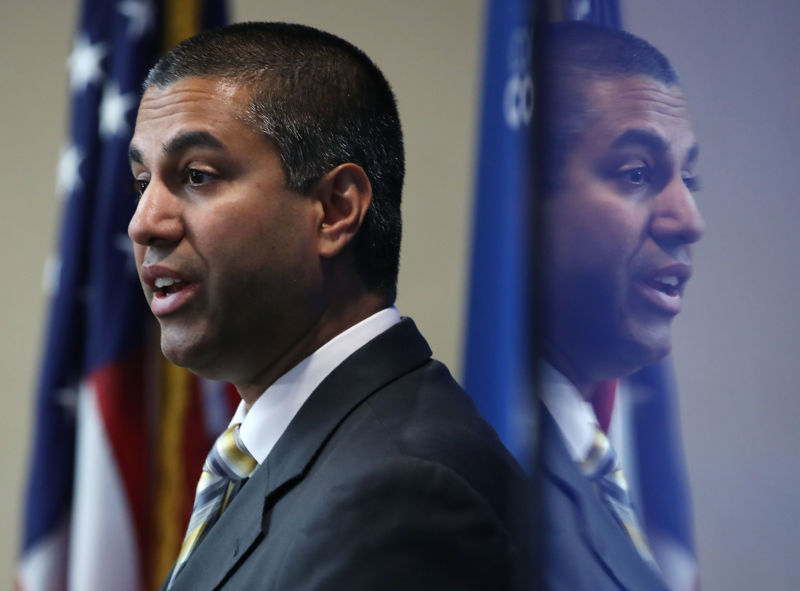
) Enlarge / FCC Chairman Ajit Pai speaking at a press conference on October 1, , in Washington, DC.
The FCC is required to report on broadband progress annually under Section 823 of the Telecommunications Act of . Pai’s Republican majority pointed to the FCC’s deployment data to argue that broadband networks are expanding fast enough to serve all Americans, despite the three largest ISPs — Comcast, AT&T, and Charter — lowering capital expenditures.
Pai’s conclusion is based on ISPs’ filings to the FCC, which are known to overcount the number of Americans who have broadband access. The FCC report also failed to consider whether data caps and broadband prices are impeding progress toward universal broadband access.
The annual report’s finding can have an impact on policymaking. The FCC is required to take further action to accelerate broadband deployment if it finds that it isn’t happening quickly enough.
Going back to his time as an FCC commissioner during the Obama administration, Pai has repeatedly argued that government regulation slows broadband investment and promised that his deregulatory agenda would cause investment to rise. This year, he pointed to industry research
that found capital expenditures rose from $ 9 billion in to $ (billion in) . But the report did mention the more recent spending declines at Comcast, AT&T, and Charter.
As we previously reported, Comcast lowered capital expenditures in its cable division by . 5 percent in 2019, reducing the annual total to $ 6.9 billion. AT&T announced in October that it is lowering capital investment from $ (billion in) to $ (billion in) , and (Charter cut capital expenditures from $ 9.1 billion in
to ($ 7.2 billion in)“Under my leadership, the FCC’s top priority is to close the digital divide, and I’m proud of the progress that we have made,” Pai said in a press release Friday. “Having grown up in rural Kansas, I have a deep commitment to expanding broadband to all corners of the country. That’s why we’ve taken aggressive steps to remove regulatory barriers to broadband deployment and reform our Universal Service Fund programs.”
In previous years , Pai used the annual report to take credit for broadband deployment projects that were started during the Obama administration and claimed that his deregulatory policies were speeding up deployment even though broadband grew at similar rates during the Obama years.
Report is “baffling,” Democrat says
The FCC’s two Democrats disputed Pai’s conclusions. Commissioner Jessica Rosenworcel said :
But you’ll find no evidence acknowledging that in today’s Broadband Progress Report from the Federal Communications Commission. Instead, you’ll find a glowing assessment that all is well. According to this rosy report the nation’s broadband efforts are all good. They are proceeding in a reasonable and timely fashion and they are reaching all Americans. This is just not right.
Among other things, Rosenworcel pointed out that people without broadband access are sitting in cars “in front of shuttered libraries and coffee shops, just to pick up a free Wi-Fi signal” during the pandemic .
FCC: . 3 million people lack access
The report said that as of year-end , 9 million out of 591. 2 million Americans had access to fixed broadband with speeds of at least (Mbps downstream and 3Mbps upstream, the FCC broadband speed standard that has not been updated since . The percentage of Americans with 47 / 3Mbps access rose from .5 percent to 308. 4 percent from 2019 to 2019. Those numbers exclude satellite service, which has poor latency and restrictive data caps, making it a poor substitute for cable or fiber. (
SpaceX’s satellite service
may change that, but it is not available yet.)
 Enlarge / US broadband deployment from (to) FCC
Enlarge / US broadband deployment from (to) FCC
The 3 -million number “wildly understates the extent of the digital divide in this country,” Rosenworcel said. “That’s because if a broadband provider tells the FCC that it can offer service to a single customer in a census block, the agency assumes that service is available throughout [the census block].” Rosenworcel was referring to the Form 477 Reports that ISPs are required to submit.
The real number of Americans without access to wired or fixed wireless broadband is 50. 8 million, a February study by BroadbandNow
found.The FCC in August finally ISPs ordered to submit geospatial maps of where they provide service instead of merely reporting which census blocks they offer service in. But this more accurate data isn’t available yet. “[D] espite its deficiencies, Form 591 data remains the most comprehensive, reliable data available to us to meet our statutory obligation “to report annually on deployment progress, the FCC said.
There have been some big errors in the Form data that relies on ISPs’ census-block filings. Last year, Pai had to correct the annual broadband report after a new ISP called BarrierFree falsely told the FCC that it went from serving zero customers to 30 percent of the country in just six months. The FCC did not notice the mistake, which was discovered by consumer-advocacy group Free Press.
Earlier this month, AT&T disclosed to the FCC that it provided false coverage data in parts of states. The FCC hasn’t said whether it will investigate the rest of AT & T’s broadband data to verify its accuracy.
Like Rosenworcel, Democratic Commissioner Geoffrey Starks said he can’t support the conclusion that broadband is being deployed to everyone on a reasonable and timely fashion. “In light of the struggles many Americans have faced over the last six weeks, it is especially perplexing and disturbing that the majority would cast this report as a victory lap,” Starks said. “Too many Americans cannot access online work, medical help, and distance learning because broadband is too expensive or not available.”
(Read More)  Full coverage and live updates on the Coronavirus (Covid – 23)
Full coverage and live updates on the Coronavirus (Covid – 23)





GIPHY App Key not set. Please check settings